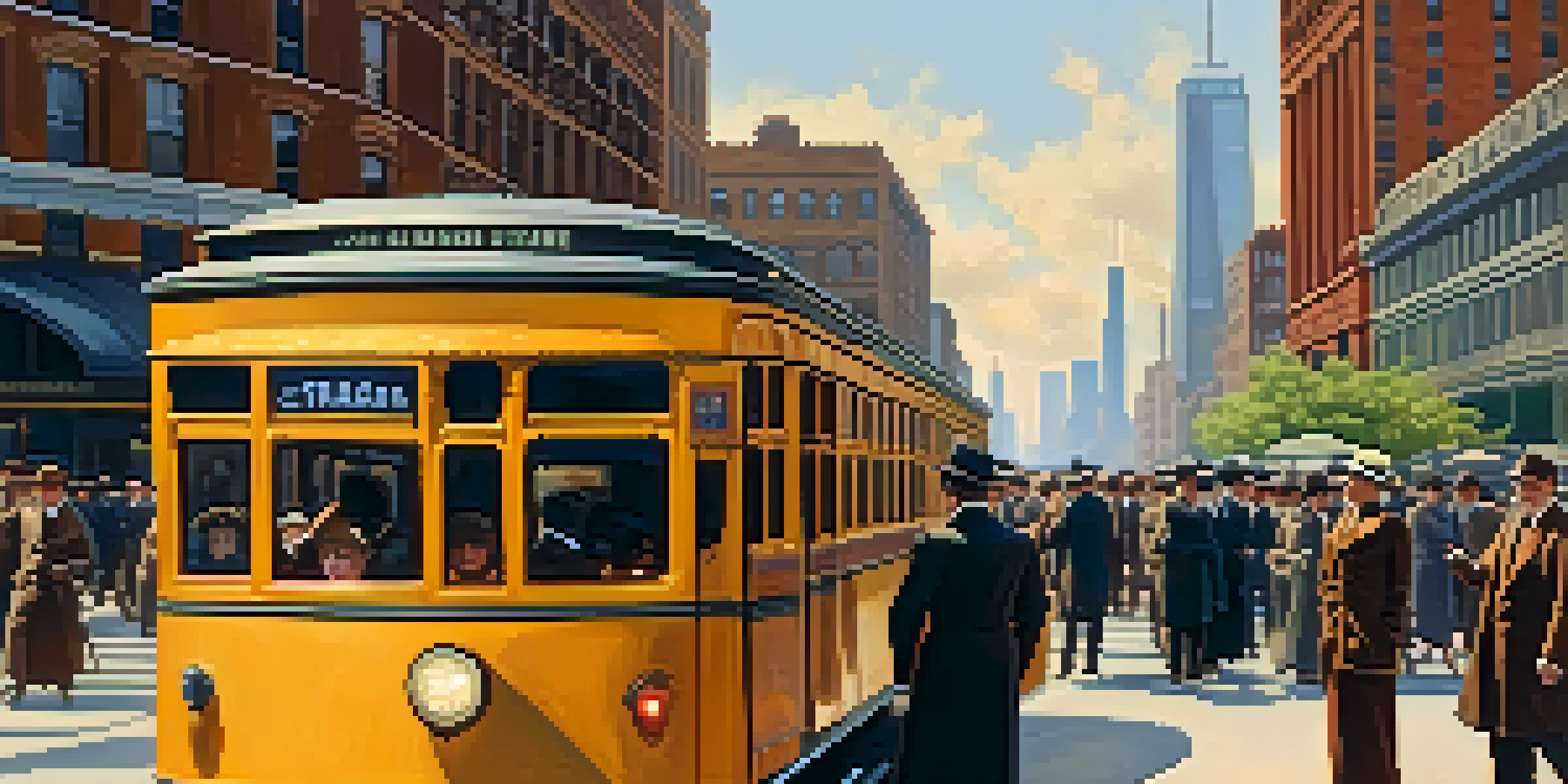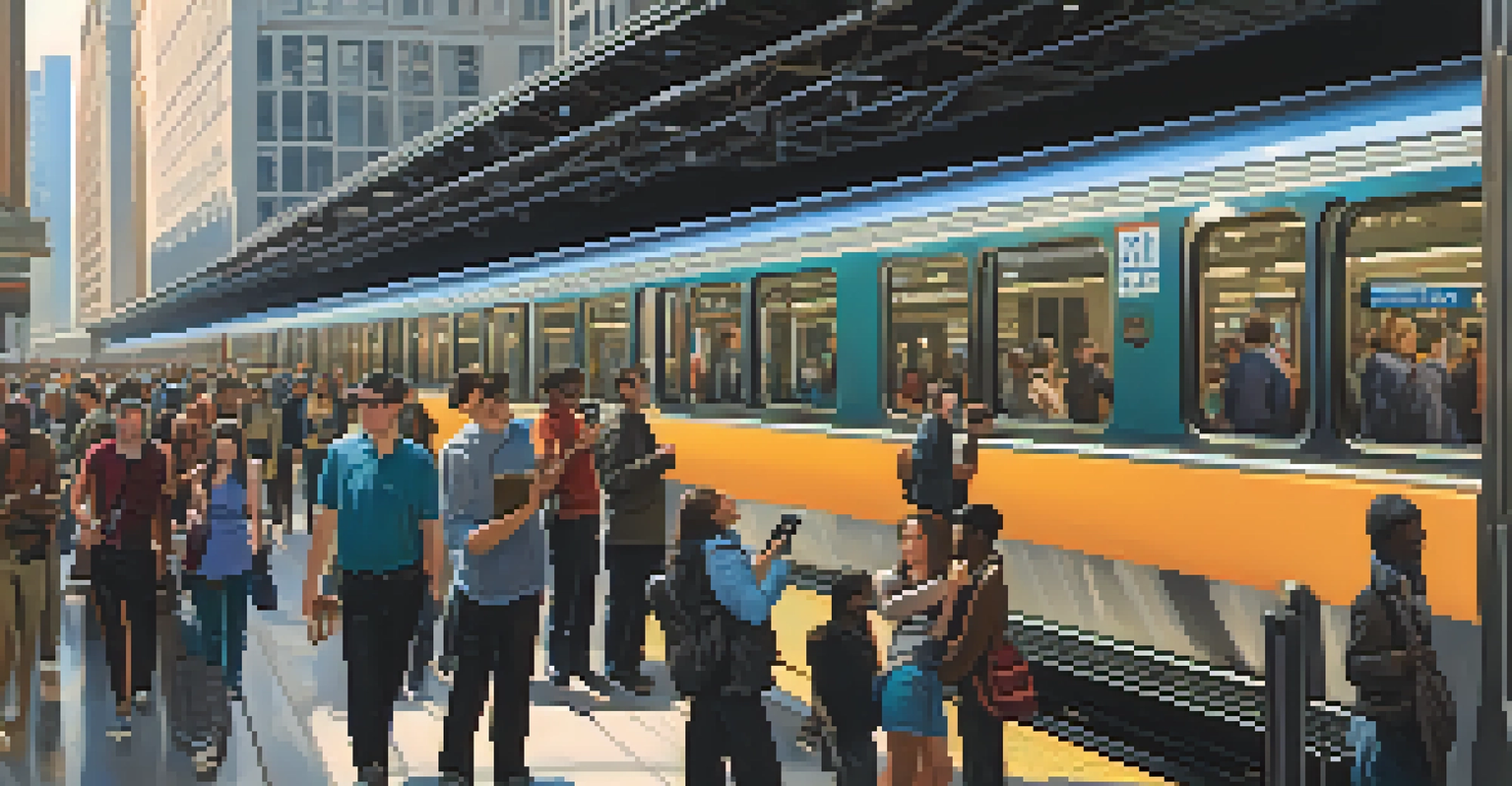Chicago's Transportation History: Evolution of the 'L' Train

The Origins of Chicago's Public Transportation System
In the late 19th century, Chicago was rapidly expanding, and the need for an efficient public transportation system became evident. Streetcars were the primary means of transport, but they struggled to keep up with the city's growth. This led to the idea of an elevated train system, which would ease congestion on the streets below and provide a faster alternative for commuters.
Public transportation is the backbone of any city and a true reflection of its culture.
In 1892, the world's first elevated railway, known as the 'L' train, began operations. It was an innovative solution that allowed trains to glide above the bustling city streets, providing a unique view of Chicago's skyline. This new mode of transportation quickly gained popularity, marking the beginning of a significant shift in how residents navigated the city.
As the 'L' expanded, so did its influence on urban development. Neighborhoods that were once hard to reach became more accessible, leading to increased business opportunities and residential growth. The 'L' train not only transformed transportation but also shaped the very fabric of Chicago itself.
The Golden Age of the 'L' Train
The early 20th century marked a golden age for the 'L' train, as it became a vital part of daily life for Chicagoans. By the 1920s, the system had grown to include multiple lines, connecting various neighborhoods and accommodating a burgeoning population. The 'L' was not just a means of transport; it became a symbol of progress and innovation.

During this time, the 'L' underwent various upgrades, including the introduction of electric trains, which replaced steam locomotives. This transition made rides smoother and more efficient, enhancing the overall experience for passengers. Additionally, the expansion of lines catered to the diverse communities in Chicago, making it easier for residents to access jobs and amenities.
Birth of Chicago's 'L' Train
The 'L' train, inaugurated in 1892, transformed urban transport in Chicago and reshaped the city's neighborhoods.
The 'L' train also played a crucial role during significant events, such as the 1893 World's Columbian Exposition and the 1933 Century of Progress International Exposition. These events showcased Chicago's growth and modernization, and the 'L' was instrumental in transporting visitors to and from these attractions, solidifying its importance in the city’s transportation narrative.
Challenges and Changes: The Mid-20th Century
Despite its success, the mid-20th century brought challenges for the 'L' train. The rise of the automobile led to a decline in ridership, as more people opted for the convenience of personal vehicles. This shift created financial strain on the 'L' system, leading to budget cuts and a reduction in services that left some neighborhoods underserved.
The 'L' train is not just a mode of transport; it’s a lifeline that connects the diverse communities of Chicago.
In response to these challenges, city officials made several attempts to modernize the 'L' and attract riders back to public transport. This included the introduction of new, more comfortable train cars and improvements to stations. However, the competition from buses and cars continued to pose significant obstacles, making it difficult to regain its former glory.
The 1970s were particularly tough, with the threat of shutdown looming over the 'L' system. Community advocates and city leaders recognized the importance of the 'L' for Chicago's identity and economy, leading to renewed efforts to stabilize and revitalize the system. This period of uncertainty ultimately set the stage for the 'L' train's revival.
Revitalization Efforts in the Late 20th Century
The late 20th century saw a resurgence of interest in public transportation, spurred by a growing awareness of environmental issues and urban congestion. In Chicago, the 'L' train became a focal point for revitalization efforts aimed at modernizing the system and improving service. This included significant investments in infrastructure and technology.
One major initiative was the introduction of the Chicago Transit Authority's (CTA) strategic plan, which focused on enhancing the customer experience. New signage, real-time tracking systems, and improved communications helped make the 'L' more user-friendly. The CTA also prioritized safety and accessibility, ensuring that more residents could easily access the 'L' stations.
Revival and Modernization Efforts
In the late 20th century, revitalization initiatives focused on improving the 'L' train's infrastructure and service, enhancing its role in the community.
These revitalization efforts paid off, as ridership began to climb once more. The 'L' train was recognized not just as a transportation option but as an integral part of Chicago's culture and identity. Events like the 'Lapalooza' festival celebrated the train's significance, drawing attention to its role in the city's vibrant community.
The Modern 'L': Technology and Sustainability
As we moved into the 21st century, technology became a central theme in the evolution of the 'L' train. The introduction of contactless payment systems and mobile apps made commuting more convenient than ever. Passengers could now plan their trips in real time, checking schedules and delays right from their smartphones.
Sustainability emerged as another vital aspect of the modern 'L' train. With increasing concerns about climate change, the CTA has focused on reducing its carbon footprint by investing in energy-efficient trains and eco-friendly stations. This commitment to sustainability not only benefits the environment but also aligns with the values of many Chicagoans who prioritize green initiatives.
Furthermore, the 'L' train continues to expand its network, with new lines and stations planned for the future. This forward-thinking approach aims to connect even more neighborhoods, ensuring that the 'L' remains a crucial lifeline for the city's residents while adapting to their evolving needs.
Cultural Impact of the 'L' Train
Beyond its practical function, the 'L' train has woven itself into the cultural fabric of Chicago. It has inspired countless songs, artworks, and stories that celebrate the unique experience of riding the 'L.' For many, the train is a symbol of the city itself, representing both the hustle and bustle of urban life and the sense of community among its riders.
Local artists have often used the 'L' as a backdrop for their work, capturing the essence of everyday life in Chicago. Murals and photographs featuring the train highlight its significance in the city’s landscape and its role in connecting diverse communities. Such artistic expressions serve as reminders of the 'L's enduring legacy.
Future of the 'L' Train
With plans for expansion and technological innovations, the 'L' train aims to remain a vital part of Chicago's transportation system.
Moreover, the 'L' train has become a space for social interaction and cultural exchange. Riders from different backgrounds share their stories and experiences during their daily commutes, fostering a sense of belonging. This aspect of the 'L' enriches the city’s culture and showcases the vibrant mosaic that is Chicago.
The Future of the 'L' Train
Looking ahead, the future of the 'L' train appears promising, with many exciting developments on the horizon. Ongoing discussions about expanding the network to underserved areas highlight a commitment to inclusivity and accessibility. The CTA aims to ensure that all Chicagoans have access to reliable public transportation, regardless of where they live.
In addition to physical expansions, there is a push for greater integration of technology into the 'L' system. Innovations such as autonomous trains and enhanced digital platforms could revolutionize the way people interact with public transport. These advancements may not only improve efficiency but also create a more seamless travel experience for commuters.

As Chicago continues to grow and evolve, the 'L' train will undoubtedly remain a cornerstone of the city's transportation landscape. Its rich history, cultural significance, and forward-thinking approach position it well to meet the challenges of the future, ensuring that it remains both a practical and cherished part of life in Chicago.